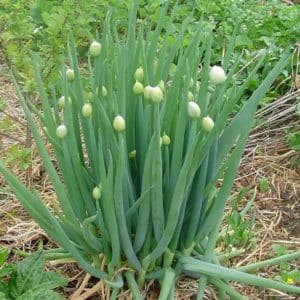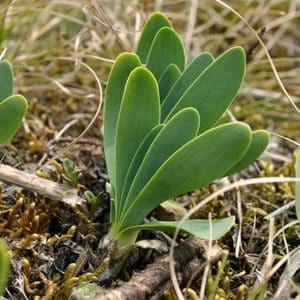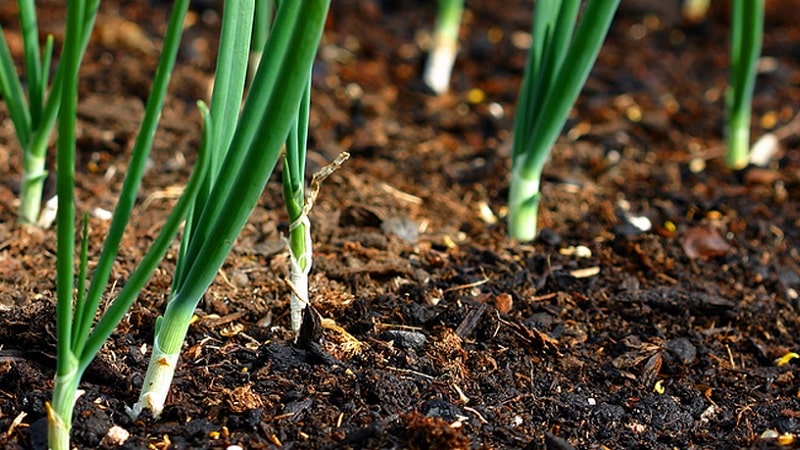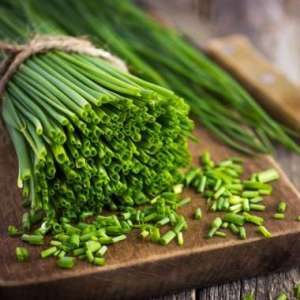Choosing which onion to plant before winter on greens and planting it correctly
Onions are usually planted for greens in the spring, but to get an earlier harvest, this is done in the fall. Such plants are more resistant to diseases and pests. To reap a rich harvest of greens, all the nuances of growing before winter are taken into account: choosing the right onion, location, planting technology and rules for caring for the crop.
Pros and cons of planting green onions before winter
The main advantage of this type of cultivation is the quick harvest of greenery. It is harvested a month earlier than onions planted in spring.
This culture is more resistant to various diseases, as it has undergone winter hardening. It is less affected by pests: the first shoots appear when many insects are not yet there. Onions are less overgrown with weeds as they develop faster. Fall planting saves time and space for other crops that are planted in the spring.
Disadvantages of growing before winter:
- low germination;
- difficulties in determining the optimal planting date due to different climatic conditions;
- If the bulb does not have time to take root before frost, it will freeze.
Which onions to plant before winter on greens
There are many types of onions suitable for planting before winter, which differ in appearance, taste and ripening time.
Batun

Onions, which are often grown for greens. Onion - perennial, grows in one place for up to ten years.
The first 3-4 years after sowing are the most productive.
Onion leaves are tubular, up to 40 cm high, up to 2 cm in diameter.Dark green, covered with a thin waxy coating. At the batun well developed root system.
The false bulb is oblong in shape, poorly developed, and has a mildly spicy taste.
Important! The species is frost-resistant. Greens grow from early spring to late autumn and tolerate low temperatures down to -8°C.
Productivity is high: up to 10 kg of leaves are cut from 1 m2 over the summer.
The most popular varieties, characterized by high yields: Maysky, Aprilsky, Russian Winter, Tenderness.
Schnitt

Another name for the species is chives. It has the shape of a spreading bush. Most often found in flower beds as a decorative ornament.
Popular varieties: Grass, Spring of the North, Green Ray, Carat, Elvi.
The leaves are tubular, up to 40 cm high. The color is bright green, the taste is pungent. The root system is branched. A small bulb forms in late summer.
Schnitt is unpretentious, resistant to low temperatures, and grows in regions with harsh climates. From 1 m2 up to 6 kg of greenery is harvested per season.
Slime

Salad onion, containing large amounts of vitamin C and iron.
It tastes more like garlic.
The leaves are wide, flat, up to 30 cm in length, dark green. The plant has a well-developed root system.
The false bulb is cylindrical in shape, with 2-3 bulbs attached to each rhizome.
From 1 m2 per season, up to 3-4 kg of greens are harvested.
The most productive varieties: Green, Leader, Charm.
Multi-tiered

The second name of the species is Egyptian.
On the peduncle of the plant, bulbs form, forming several tiers.
The height of the first tier reaches 50 cm, the subsequent ones - up to 20 cm. Up to 4-5 tiers are formed in one season.
The leaves are hollow, up to 80 cm long, dark green with a waxy coating.
The taste is spicy. A false bulb is formed. The root system is branched.
Onions are resistant to low temperatures. During the season, 3-4 kg of greens are collected from 1 m2.
Popular varieties: Likova, Memory, Chelyabinsk.
When to plant onions
Depending on the weather, the timing of planting before winter varies even within the same region. They are planted so that the bulbs have time to take root before the first frost, but do not sprout.
Planting is usually carried out in the second half of October, a month before frost. The optimal air temperature is +5°C, soil temperature is +3°C.
Important! The seeds are buried when the soil is frozen to -3°C. Depending on the region, sowing is carried out in November-December.
There are no specific deadlines for growing onions for greens in greenhouses.
The best predecessors
In order for onions to produce a rich harvest, the planting site must be properly prepared. Choose a well-ventilated area, but without drafts. You cannot grow onions where water accumulates in the spring, otherwise the planting material will rot.
Particular attention is paid to what crops grew on the site. The best predecessors of onions: beets, legumes, cabbage, mustard, melons and watermelons. Do not plant the plant after potatoes, celery, parsley, and alfalfa.
Preparation of planting material
Onions are planted with seeds and bulbs before winter.
The seeds are pre-disinfected: soaked for 20–30 minutes in a 2% solution of potassium permanganate or for 5–10 minutes in 70% alcohol. Then they are dried to a free-flowing state at room temperature.
For planting, select a solid seed without damage, measuring from 2.5 to 4 cm. It is soaked for 20–30 minutes in a solution of potassium permanganate and dried at room temperature.
Reference. To obtain uniform seedlings, choose bulbs of the same size.
Soil preparation
The selected area is cleared of the remnants of the autumn harvest to avoid fungal diseases and pests.
The soil is dug up to a depth of 20 cm, humus or compost is added (1-2 buckets per 1 m2). Potassium and phosphorus fertilizers are added to depleted soils (15 g of potassium chloride, 25 g of superphosphate, 25 g of ammonium nitrate per 1 m2) so that the planting material takes root and overwinters.
To reduce acidity, add ash (150 g per 1 m2). Then the beds are formed.
How to plant correctly

When planting onions with seeds in the beds, make grooves 2-3 cm deep, the distance between them is maintained at 25-30 cm. The seeding rate is 1.5 g per 1 m2. The furrows are sprinkled with soil and mulched with a 2-3 cm layer of humus to prevent future plants from getting too cold.
Sevok is planted using a belt or bridge method:
- With the tape method, grooves 3–5 cm deep are made in the beds every 20 cm. Bulbs are inserted into them at a distance of 10 cm from each other and sprinkled with earth. Then mulch with a layer of mowed grass and fallen leaves.
- For bridge planting, ridges 10–15 cm high and 1 m wide are formed. The distance between them is 50 cm. The soil is loosened to a depth of 7 cm. Then the bulbs are inserted close to each other to a depth of 3–5 cm. The surface is mulched with layers of grass or fallen leaves.
Care
If there is little snow in winter, the mulched beds are covered with film. With the onset of spring, the film is removed so that the planting material does not rot.
In the spring, with the onset of warm weather, snow is cleared from the beds so that they warm up faster.
After the emergence of seedlings, the greens are thinned out and the first fertilizing is carried out. The beds are watered with mullein infusion (1:5 with water).If the greens grow slowly, then after 2-3 weeks they are fertilized again: potassium salt, saltpeter and superphosphate, taken in a ratio of 1:1:2, are added to 10 liters of water.
The emerging seedlings are watered abundantly for the first 14 days, then once every 8–12 days. As weeds appear, the beds are weeded. After watering, the soil must be loosened: this helps the roots breathe and accelerates the growth of the crop.
Disease and pest control

During growth and development, onions are susceptible to various diseases and pest attacks. To prevent this, observe crop rotation when planting, do not flood the crop, thin out and remove weeds.
Advice. To obtain a high-quality harvest of greens, plants are not treated with chemicals.
Downy mildew
With peronosporosis, the leaves become covered with a white coating. The causative agent of the disease is a fungus that is found in the upper layers of the soil. For prevention, onions are planted in a well-ventilated place and the watering regime is observed.
To combat the disease, diseased plants are removed from the beds, watering is reduced and fertilizing is stopped. Plants are sprayed with a solution of soda ash (1 tablespoon per 10 liters of water) or copper sulfate (10 g per 0.5 liter of water).
Onion rust
Yellow-brown spots and convex formations appear on the leaves, in which fungal spores mature. The leaves turn yellow and dry out. For prevention, the remains of last year’s plants are carefully removed from the beds and the soil is dug up.
Infected specimens are removed and watering is reduced. Onions are sprayed with the preparation “HOM” (40 g per 10 liters of water). The procedure is repeated a week later.
Onion fly
Fly larvae They eat the underground part of the plant - it turns yellow and withers.For prevention, the soil is dug up in the fall and the seed material is disinfected before planting.
To combat the pest, the rows are watered with a saline solution (300 g of salt per 10 liters of water). Repeat the procedure after two weeks.
Secretive Proboscis
It lays eggs inside onion feathers, and the hatched larvae eat the flesh from the inside. For prevention, regularly loosen the soil and remove plant debris.
To get rid of the insect, plants are sprinkled with a mixture of tobacco dust and ash in a 1:2 ratio.
Trips
The larvae of this insect suck the juice from green feathers. Leaves are deformed, crop growth slows down. For prevention in the fall, dig up the soil, loosen it regularly, and plant celandine or mustard next to the onions.
To get rid of the insect, onions are sprayed with a solution of red pepper. To prepare it, add 1 kg of red hot pepper to 10 liters of water, boil and cool. The resulting solution is diluted with clean water (125 ml of solution per 10 liters of water). Spraying is repeated after a week.
Features of growing in a greenhouse
A greenhouse for growing onions for greens is equipped with shelving, lighting fixtures, and a heating system. The optimal temperature for the crop during the day is +20°C, at night - +13...+14°C.
Sandy soil is used for cultivation. Before planting, fertilizers are applied to the soil: per 1 m2, one bucket of compost or humus, 1 tsp. sodium chloride, 2 tsp. superphosphate. Onions are planted using strip and bridge methods.
After the emergence of seedlings, fertilizing is carried out (1 teaspoon of urea per 10 liters of water). Water the plants as the soil dries, every 2-3 days.
Harvest and storage
Feathers grow constantly, so there is no specific time frame for harvesting. Greens are cut when their length reaches 30 cm.Re-harvest when it grows back.
Important! Feathers are cut at least 5 cm from the ground. Fold into bundles and store horizontally.
In the refrigerator, in the vegetable drawer, fresh greens can be stored for up to thirty days. To increase the shelf life to one year, the product is frozen or dried.

To freeze, greens are chopped, placed in bags or containers and placed in the freezer.
Feathers are dried in crushed form in an oven, dryer or in the open air. Store the finished product in glass jars or paper bags in a dry, dark place.
Conclusion
To obtain an early harvest of green onions, they are planted before winter. This culture is resistant to various diseases and pests.
It is important to choose the right planting time so that the seed takes root before the first frost, but does not sprout. Further care does not require much effort: the plants are watered, fertilized, weeded and thinned.